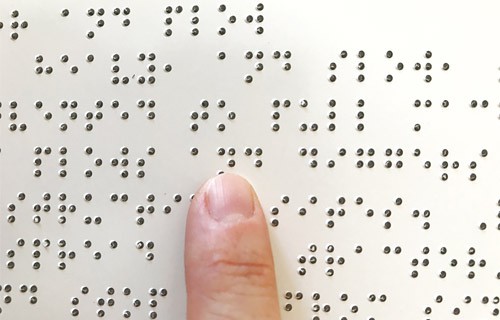Write and Read Braille
Summary
Introduction
Have you ever been in an elevator and wondered what the many little dots on the buttons are for? You can also find these dots in public buildings on room number signs or on ATMs. These arrangements of dots are a special writing system for the visually impaired called braille. By feeling the dots with their fingers, people can read what is written on a sign or elevator button. Do you want to find out how to read with your fingers? This activity will show you how!Materials
- Graph paper
- Parchment paper
- Pencil or other pointed object such as a knitting needle
- Cardboard
- Computer with access to the internet
- Tape
- Helper
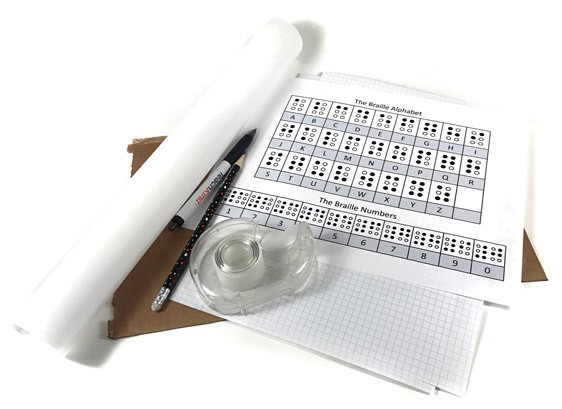 Image Credit: Svenja Lohner, Science Buddies / Science Buddies
Image Credit: Svenja Lohner, Science Buddies / Science Buddies
Prep Work
- On the internet, look up the Braille alphabet to see which dot pattern stands for each letter.
- Place the graph paper on top of the cardboard.
Instructions
- Choose one square and carefully press down on the paper with the tip of the pencil or knitting needle. Be careful not to puncture the paper.
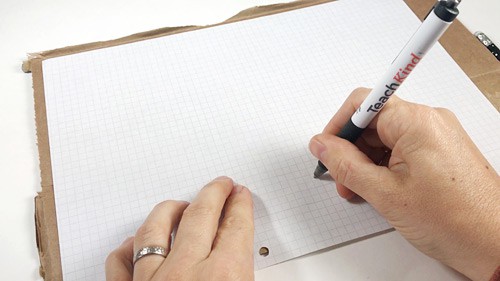 Image Credit: Svenja Lohner, Science Buddies / Science Buddies
Image Credit: Svenja Lohner, Science Buddies / Science Buddies
- Flip the graph paper over. Can you see the raised bump in the paper? Run your index fingertip over the punched spot.How does it feel? What letter does one dot stand for?
- Repeat step one, but this time, choose two squares next to each other and punch lightly onto the paper with the tip of the pencil.When you flip your paper over, can you feel both bumps next to each other with your fingertips? Which letter does your chosen dot pattern stand for?
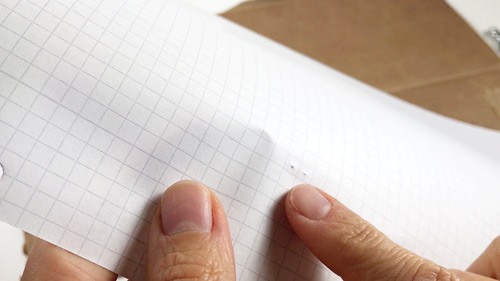 Image Credit: Svenja Lohner, Science Buddies / Science Buddies
Image Credit: Svenja Lohner, Science Buddies / Science Buddies
- Next, place the parchment paper onto the graph paper. It helps if you tape them together. Think of a whole word to write and with the help of the braille alphabet, write the corresponding dot patterns onto your parchment paper. The graph paper underneath helps you to keep the dots in line.
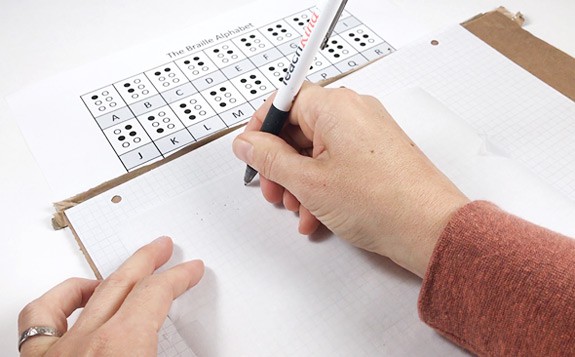 Image Credit: Svenja Lohner, Science Buddies / Science Buddies
Image Credit: Svenja Lohner, Science Buddies / Science Buddies
- Keep the graph paper on top of the cardboard, flip over the parchment paper, and lay it on top of the graph paper. Again, press on each dot of your dot pattern written on the parchment paper to create bumps in the graph paper underneath.Why do you have to do this step and flip over the parchment paper to copy the dot pattern on the graph paper again?
- Once you are done, flip your graph paper over and compare your dot pattern with the one you made in step 4.How do they both compare? How are they similar or different from each other?
- Now try to tread the correct dot pattern with your fingers.Are you able to make out the individual letters? Can you read the whole word? Does it make a difference if you read with your eyes closed or open?
- Ask your helper to create a letter dot pattern for you the same way you did it in steps 1 and 3. He or she should keep the letter secret from you. Once your helper has completed the dot pattern, check the braille alphabet once more, and then close your eyes. Try to identify the letter with your fingertips without looking.Can you identify the right letter?
- Repeat step 8 as often as you like or make it more difficult and ask your helper to write a whole word in braille for you. Can you read the word with closed eyes?
Cleanup
What Happened?
Were you able to read with your fingers? It can be quite challenging if you are not used to it. However, you should have been able to feel the bumps on the graph paper that you made with your pencil. If you run your index finger across the paper, the touch receptors in your fingertips recognize the difference between the flat paper and the bump. This triggers your receptors and they send a signal from the nerves in your fingertips to your brain. This way you know how many bumps you felt on the paper and in which position in the 6-dot cell they were.
Usually the index fingers are used to read braille, although the other fingers should have been able to identify the bumps as well. It makes a difference how close or far apart you space the individual dots: if they are too far away, one fingertip alone is not able to detect them anymore. If they are too close together, your finger might not be able to identify them as two separate dots. Now that you know how braille works, try reading it with your fingers the next time you see it!
Digging Deeper
Being able to see was for a long time a prerequisite for reading. No other reading medium was available for people who were blind or had impaired vision. This only changed in the early 1800s when Samuel Gridley Howe, the founder of the New England School for the Blind, created Boston Line Type, the first writing system for the blind. The system was based on a tactile reading code, which means reading by touch.
This type of reading is possible because our fingertips contain a huge network of nerve endings and touch receptors that allow us to detect tiny bumps on a piece of paper. Once these touch receptors are activated by feeling a bump, a signal is sent from the nerves in our fingertips all the way into our brain, which is then able to decode the information we gained by touching the paper.
While Boston Line Type consisted of an embossed simplified Roman alphabet, the braille system developed later by Louis Braille consists of arbitrary characters composed of several dots. These raised dots are arranged in a 6-dot cell and a different pattern is assigned to each letter of the alphabet. Braille got this idea from a military code called night writing. This code allowed soldiers to communicate during the night without making any sounds or using light. Although several other tactile writing systems have been developed over time, braille has been widely adopted and is still in use today. If you look closely, you can see these dots in many places, such as elevator buttons, ATMs, and various signs in public buildings.
Ask an Expert
For Further Exploration
- Does it make a difference which fingertip you use for reading? Try using your middle finger or pinky instead of your index finger and see which finger is best in identifying the writing.
- You can also read braille with two hands. Braille readers use the index fingers of both the left and right hands simultaneously to reduce their reading time. How does reading with one hand compare to reading with two hands?
- Try to change the spacing between your dots. Can you read your letters better if the dots are closer to each other, or further apart?


